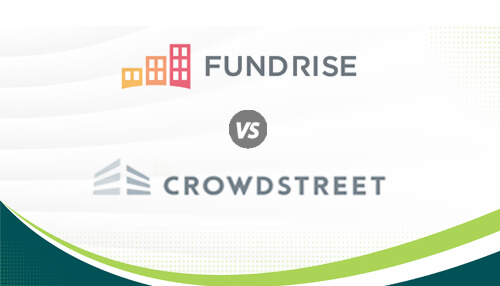Which real estate investment platform is right for your portfolio?
In this Comparison
- Fundrise Overview
- Crowdstreet Overview
- 3 Key Differences Between Fundrise and Crowdsteet
- Things to Remember about Fundrise vs Crowdstreet
- The Bottom Line – Which is Best for You?
Fundrise Overview
Fundrise is a crowdfunding investment platform focused on real estate property and real estate REITs. It was founded in 2012 with its headquarters in Washington, DC.
Most of your investing can be done via their app or online. It should be noted that they show over 22k reviews in the Apple App Store.
The platform offers investors five different account levels from Starter to Premium with minimum investments ranging from $10, $1,000, $5,000, $10,000, and up to $100,000.
It charges an annual fee on funds invested of 1% (0.15% advisory + 0.85% managing). And also charges fees for early liquidation.
The platform requires you to leave your funds in place for five years before you can withdraw funds penalty-free.
It should be noted that Fundrise holds the properties within a REIT, Real Estate Investment Trust. They offer several different accounts and funds and some of their funds include equity securities (ETFs) along with ownership of actual property.
Explore more about Fundrise here.
Open your Fundrise account here.
Crowdstreet Overview
The Crowdstreet was founded in 2014 with its main headquarters in Austin, TX with a Portland, OR office and many remote employees. Crowdstreet is a marketplace for accredited investors to do crowdfunded deals with real estate sponsors. Sponsors are individuals and companies selling properties that they own or represent. Explore more about Crowdstreet here.
You must meet at least one of the following criteria to be considered accredited.
- Over $200,000 average annual earnings over the past 2 years ($300,000 for joint)
- Over $1 Million in net worth excluding your primary home
- Some businesses or institutions can invest as accredited under certain guidelines.
- As of August 26, 2020, the SEC has opened up the accredited status to some financial professionals with defined experience and certifications.
In order to invest with Crowdstreet you must invest a minimum of $25,000 for most of their deals. Investors should also be prepared for a long-term (5+ years) holding period as this investment is illiquid.
Crowdstreet does offer investors several different account types and you can invest in single deals or real estate funds (which hold several deals and REITs).
Follow this link to get started with Crowdstreet.
3 Differences Between Fundrise and Crowdstreet
The main difference between Fundrise and Crowdstreet is the fact that Crowdstreet only works with accredited investors. This means their deals can be complicated and more involved.
This doesn’t necessarily mean their deals are more risky or higher performing but they do give investors access to projects that aren’t suitable for other investors – according to the SEC.
Secondly, Fundrise charges a 1% fee on all funds held. Crowdstreet doesn’t proclaim to have an advisory or management fee on funds but they do have several different fees depending on the investment.
Finally, Fundrise offers an easy-to-use app that makes their investments accessible on a smartphone. Their app is simple and easy to use but investors need to remember that they aren’t investing in stocks – but actual properties.
| Fundrise | Crowdstreet |
| $10 min – any investor | $25,000 min, accredited |
| Popular App | No App |
| Long term investing | Long term investing |
Another article on this comparison can be read here.
Things to Remember about Fundrise vs Crowdstreet
According to Apple app reviews and other articles many new investors don’t like the illiquidity of Fundrise. It could be frustrating if an investor is used to apps like Robinhood that are ultra-liquid and easy to use with no fees.
However, investors need to remember that Fundrise and Crowdstreet are crowdfunding into actual properties. Real estate in general is not something you can buy one day and sell immediately.
The platform has addressed some investors’ concerns with “early redemption” fees and penalties and they have made the process better. In 2021, they announced a flat 1% fee for some of their funds.
This flat fee, which does not cover their fundamental flagship fund, signifies that investors ought to assume committing to long-term investments and might stumble upon demanding situations if they are seeking to withdraw the budget upfront. It’s important for investors to be aware of these capacity boundaries and to carefully consider their investment approach before making any decisions about early withdrawals.
Overall, I find Crowdstreet’s platform and website to be exceptionally professional and informative. While I am not yet classified as an accredited investor, I am confident in the legitimacy of Crowdstreet. The detailed resources and user-friendly interface on their website have impressed me, making me eager to progress towards accredited status to fully leverage the investment opportunities available through Crowdstreet.
The Bottom Line – Which is Best for You?
Fundrise allows the common investor to effortlessly diversify their portfolio by imparting them the opportunity to personal a fractional share of actual property, making actual property funding more available. This aligns perfectly with the essence of crowdfunding, which is all about democratizing funding opportunities and empowering personal investors to take part in traditionally exclusive asset training like real estate.
If you’re inquisitive about gaining further insight into Fundrise returns, there’s a wealth of information to be had to help you completely recognize the potential benefits and returns that can be achieved through making an investment with Fundrise.
If you are interested in gaining knowledge of extra approximately real estate crowdfunding, you can click here to explore investment opportunities and find out how you may participate in this innovative shape of funding inside the real estate marketplace.



